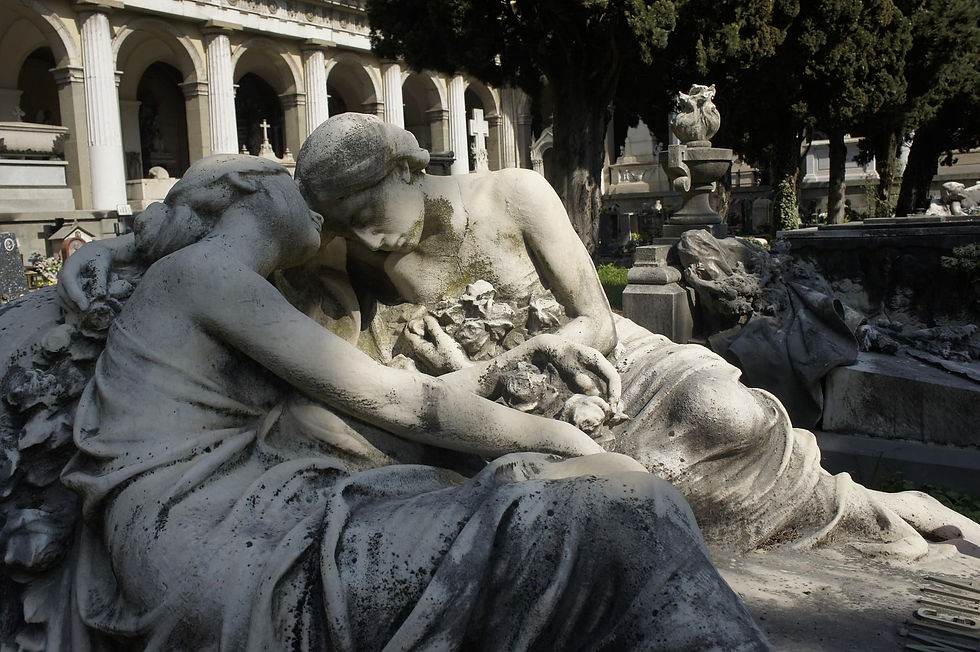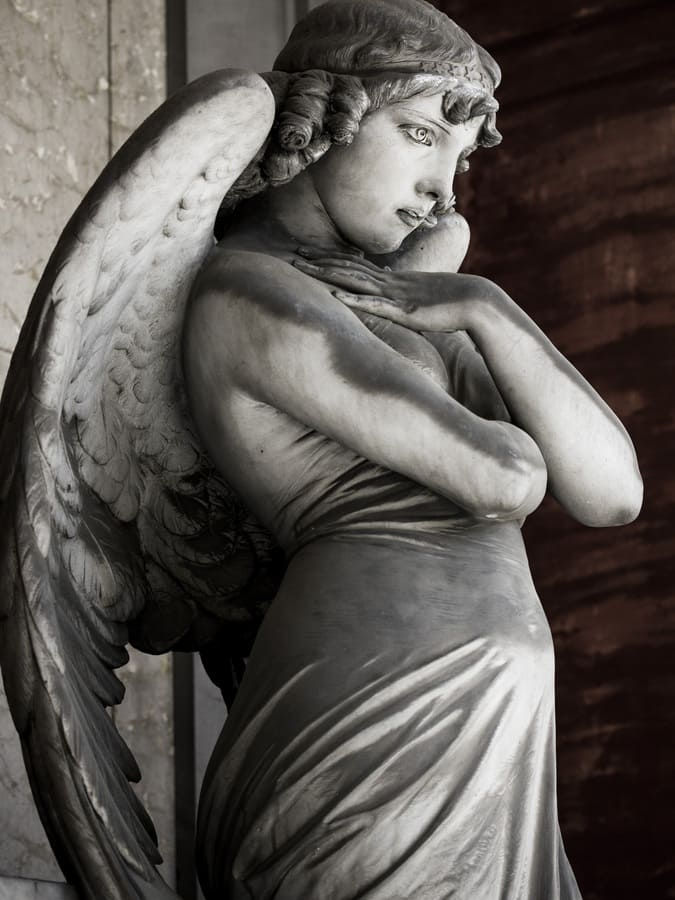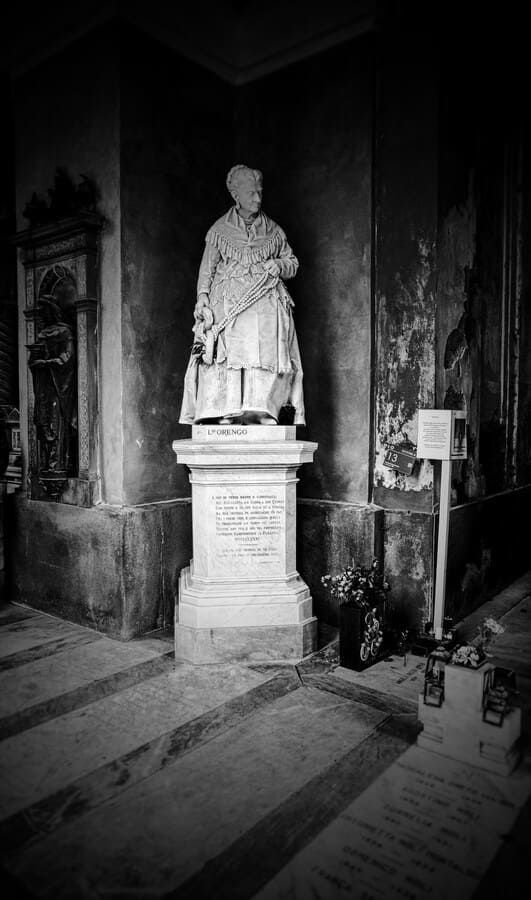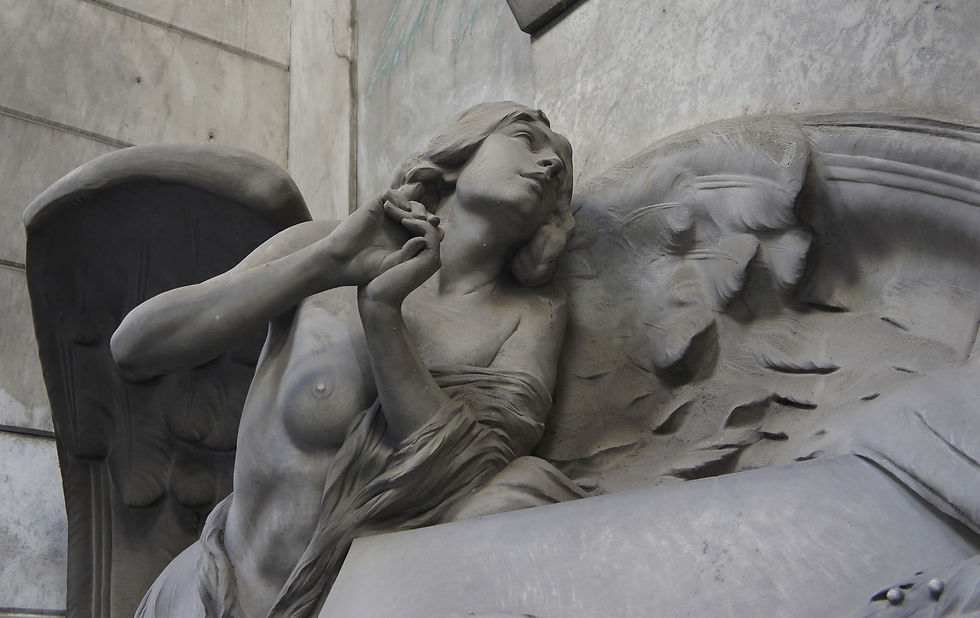Monumental Cemetery of Staglieno: An Open-Air Museum in the Heart of Genoa
- veronicameriggi
- 26 ago
- Tempo di lettura: 6 min
The Monumental Cemetery of Staglieno is one of those places that can surprise and move you at the same time. Born in the 19th century as the city’s main cemetery, today it is considered one of the most extraordinary examples of funerary art in Europe. Among tree-lined avenues, arcades, and hills, you will find monumental sculptures, family chapels, and memorials that tell stories from different eras. Walking through Staglieno is not just visiting a cemetery – it’s entering a true open-air museum, where every statue and inscription preserves fragments of timeless memory and beauty.
History and Origins of the Cemetery of Staglieno
The project for the Monumental Cemetery of Staglieno was conceived in the first half of the 19th century, in response to the need to provide Genoa with a large modern cemetery located outside the inhabited area, as required by the health regulations of the time. The choice fell on the Staglieno area, then a peripheral location surrounded by greenery, perfect for hosting a vast and scenic monumental complex.
The initial idea dates back to the 1830s, but the final design took shape in 1835, entrusted to the Genoese architect Carlo Barabino, also the author of other important works in the city. After his death, the work was continued by his pupil Giovanni Battista Resasco, who expanded the design and oversaw its construction.
The cemetery was officially inaugurated in 1851 and quickly became a symbolic place for the city, thanks to the balance between neoclassical architecture, scenic landscaping, and sculptural art.
Over the decades, Staglieno has been enriched by the work of many sculptors and architects who transformed the complex into a true museum of funerary art. Among the most famous names are Santo Varni, Giulio Monteverde, Ettore Ximenes, and Leonardo Bistolfi, along with many Ligurian artists who contributed statues, bas-reliefs, and chapels with great emotional impact. The works range from 19th-century realism to symbolism, creating an artistic journey that tells not only the history of Genoa but also the evolution of art and taste over more than a century and a half.

An Open-Air Museum
Visiting the Monumental Cemetery of Staglieno means strolling through one of the largest open-air museums in Europe. Here, funerary art is not just decoration but storytelling: every monument, statue, and inscription is a fragment of life transformed into stone or marble, capable of moving even those with no direct connection to the people commemorated.
Sculptures and Works of Art
The complex houses thousands of works, from simple headstones to imposing family chapels. Some sculptures have become true icons, such as Monteverde’s Angel on the Oneto tomb, a masterpiece of expressiveness and movement, or Santo Varni’s Flower Seller, famous for the delicacy of its details.
Each tomb is a unique work, often commissioned by wealthy Genoese families wishing to leave an eternal mark of their memory.

Styles and Artistic Movements
As you walk among the arcades and avenues, you will encounter works ranging from 19th-century neoclassicism, with its harmonious forms and ideals of classical beauty, to realism, portraying the deceased with surprising accuracy, and finally to symbolism and art nouveau, rich in allegories and floral decorations. This variety makes Staglieno a unique place, where the evolution of European art intertwines with Genoese history and culture.
Famous Figures Buried in Staglieno
The Monumental Cemetery of Staglieno preserves the memories of figures who marked both Italian and international history. Along its avenues and arcades, you’ll find the graves of patriots, artists, writers, musicians, and entrepreneurs – a heritage that makes this place a living archive of biographies and masterpieces.
Politicians, Artists, and Historical Figures
Among the most notable names is Giuseppe Mazzini, whose neoclassical mausoleum is located in the Boschetto dei Mille. Inside, you’ll find flags and dedications from European figures, evidence of his international legacy. Nino Bixio rests in the Pantheon, while among Ligurian entrepreneurs we find Raffaele Rubattino.
In the 20th century, the cemetery welcomed Fabrizio De André (Chapel – Field 22) and Edoardo Sanguineti (Pantheon LXIV). There are also notable women, such as Anna Maria Ortese and Fernanda Pivano (Columbarium). On an international level, Constance Mary Lloyd, wife of Oscar Wilde, is buried here in the Protestant Cemetery.
Iconic Memorials and Monuments
One of the most famous monuments is Monteverde’s Angel on the Oneto tomb: a figure of graceful power that marks the transition from 19th-century realism to a more symbolist atmosphere. It is one of Staglieno’s most recognisable masterpieces.
Another beloved symbol is the statue of Caterina Campodonico, the “peanut seller”: a popular and very lifelike portrait, commissioned by the woman herself and sculpted by Lorenzo Orengo in 1881. It tells the story of the city with the same vigour as its grand monuments.
Completing the picture are Mazzini’s mausoleum, designed by Vittorio Giovanni Grasso, and various commemorative areas: from the Campo dei Mille to the English Cemetery, and the monument to the victims of Nazi-Fascist deportations along the Veilino. These sites and the many plaques scattered throughout the complex guide visitors through a historical journey spanning the Risorgimento, wars, the Resistance, and civic memory.

Visiting the Monumental Cemetery of Staglieno
As one of Genoa’s most evocative landmarks, the Monumental Cemetery of Staglieno is also easy to access for those wishing to explore it at leisure. The size of the complex and the richness of the works make it worthwhile to plan your visit in advance so you don’t miss the most important points.
Opening Hours and Admission
Admission to the Cemetery of Staglieno is free. It is generally open daily, from early morning until late afternoon (with extended hours in summer), but it is always advisable to check the updated schedule on the official City of Genoa website or at the tourist information office.
The main entrance is located in Piazzale Giovanni Battista Resasco, where maps and visitor materials are also available.
Guided Tours and Recommended Routes
Given the vastness of the complex, one of the best options is to join a guided tour, organised by licensed guides or local cultural associations. There are thematic routes focusing on the most famous sculptures, the graves of notable figures, or the symbolic aspects of funerary art.
For those who prefer to explore independently, maps and self-guided itineraries are available, allowing you to visit key spots such as the Pantheon, the Boschetto dei Mille, the Protestant Cemetery, and the monumental arcades.
Practical tip: allow at least two hours for your visit and wear comfortable shoes, as the routes include uphill avenues and large pedestrian areas.
Curiosities and Anecdotes
The Monumental Cemetery of Staglieno is a place that thrives on details: engraved mottos, carved allegories, and portraits so realistic they seem alive. In addition to the graves of famous figures, here you’ll find sculptural masterpieces that have travelled the world through guidebooks, catalogues, and international exhibitions.
The Oneto Tomb and Its Famous Sculptures
Among the most photographed works is the Oneto tomb, made iconic by Giulio Monteverde’s Angel: a youthful, elegant figure, with partially open wings and a gaze suspended between grace and melancholy. The drapery, posture, and movement of the feathers are a display of technical virtuosity that marks the transition from 19th-century realism to a more symbolist sensibility.
The monumental setting interacts with the angel: garlands, urns, and floral motifs guide the eye and create a scenic composition that still impresses today with its balance and expressive power. It is a work that alone justifies the visit, reflecting the taste and ambition of Genoa’s bourgeois families of the time.
Legends and Hidden Symbols
As you wander among arcades and chapels, you’ll encounter recurring symbols:
Poppies and hourglasses represent sleep and the passage of time.
Broken columns symbolise a life cut short.
Anchors and ship’s wheels refer to the maritime tradition.
Veiled female figures evoke mourning but also hope.
There are also anecdotes: some statues are famous for the startling realism of their portraits, others for the use of fine materials such as Carrara marble with bronze inlays. Certain popular graves, like that of Caterina Campodonico, have become “places of affection” where locals bring flowers and leave notes, maintaining a spontaneous relationship with memory.
One of the most enduring tales is the belief that certain angels “guard” the avenues in the quietest hours – more suggestion than documented story, but one that adds to the site’s atmosphere.

How to Get to the Cemetery of Staglieno: By Bus, Car, or On Foot
Starting from Hotel Astoria (Brignole area), reaching the Monumental Cemetery of Staglieno is quick and easy. If you are planning a stay in Genoa to visit Staglieno and other attractions, check out Hotel Astoria’s special offers to make your visit even more comfortable and convenient.
Here are the most convenient options to get to the cemetery:
By bus
From Genova Brignole station, several lines go directly towards Staglieno / Val Bisagno, stopping near the main entrance in Piazzale Giovanni Battista Resasco. The route is straightforward: follow the valley along the Bisagno riverbank and get off at “Staglieno – Cimitero” stop. Average travel time is about 15–20 minutes, depending on traffic. You can check updated schedules on the AMT Genova website or app.
By Car
From the hotel, take Corso Buenos Aires → Corso Sardegna / Corso Monte Grappa → Piazzale Resasco. The drive takes 10–15 minutes depending on traffic. Street parking is available nearby; when possible, it’s best to park close to the main entrance.
On Foot
For those who enjoy walking, the cemetery is about 3–3.5 km from Brignole: an urban route with a slight uphill slope along the Val Bisagno. Allow 40–50 minutes at a leisurely pace.
_edited.png)